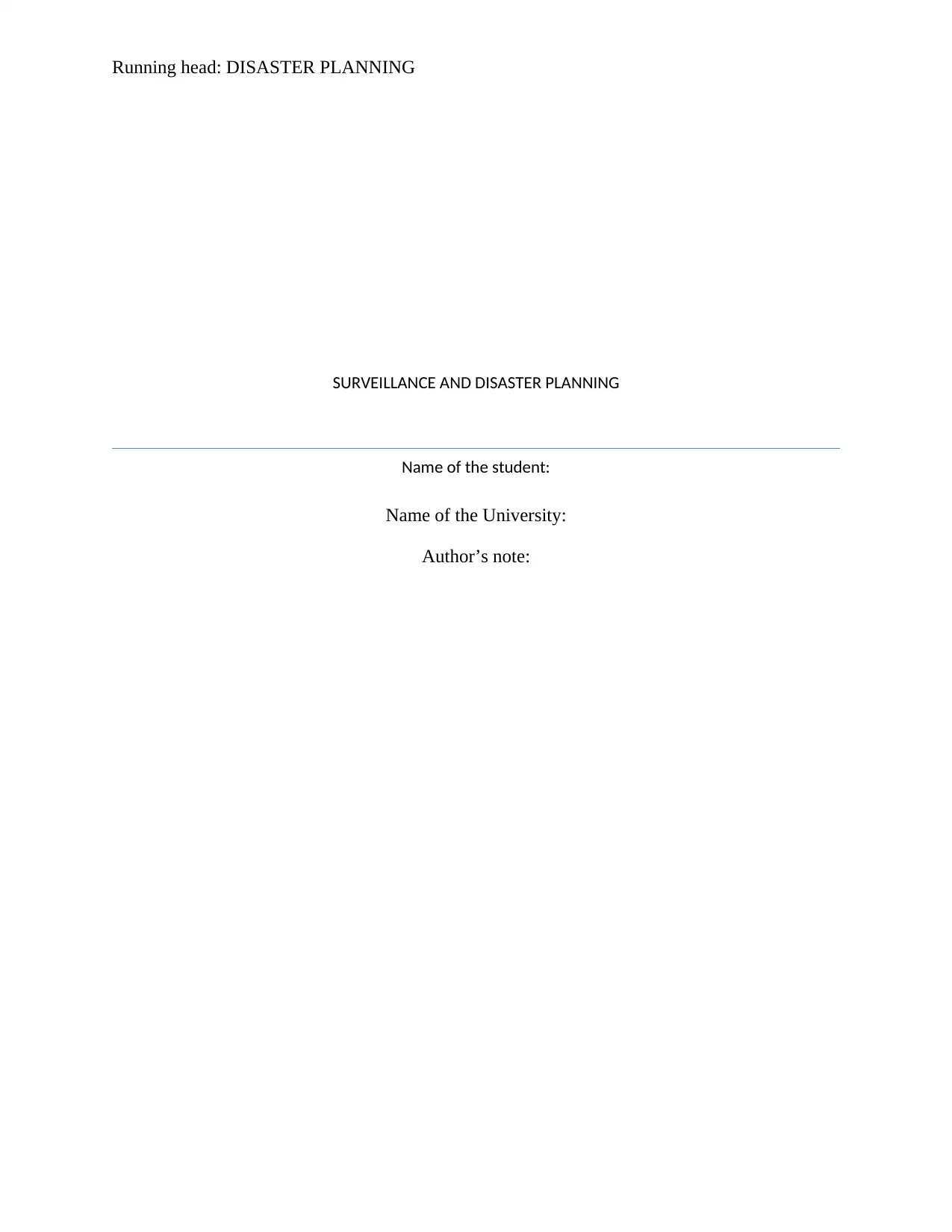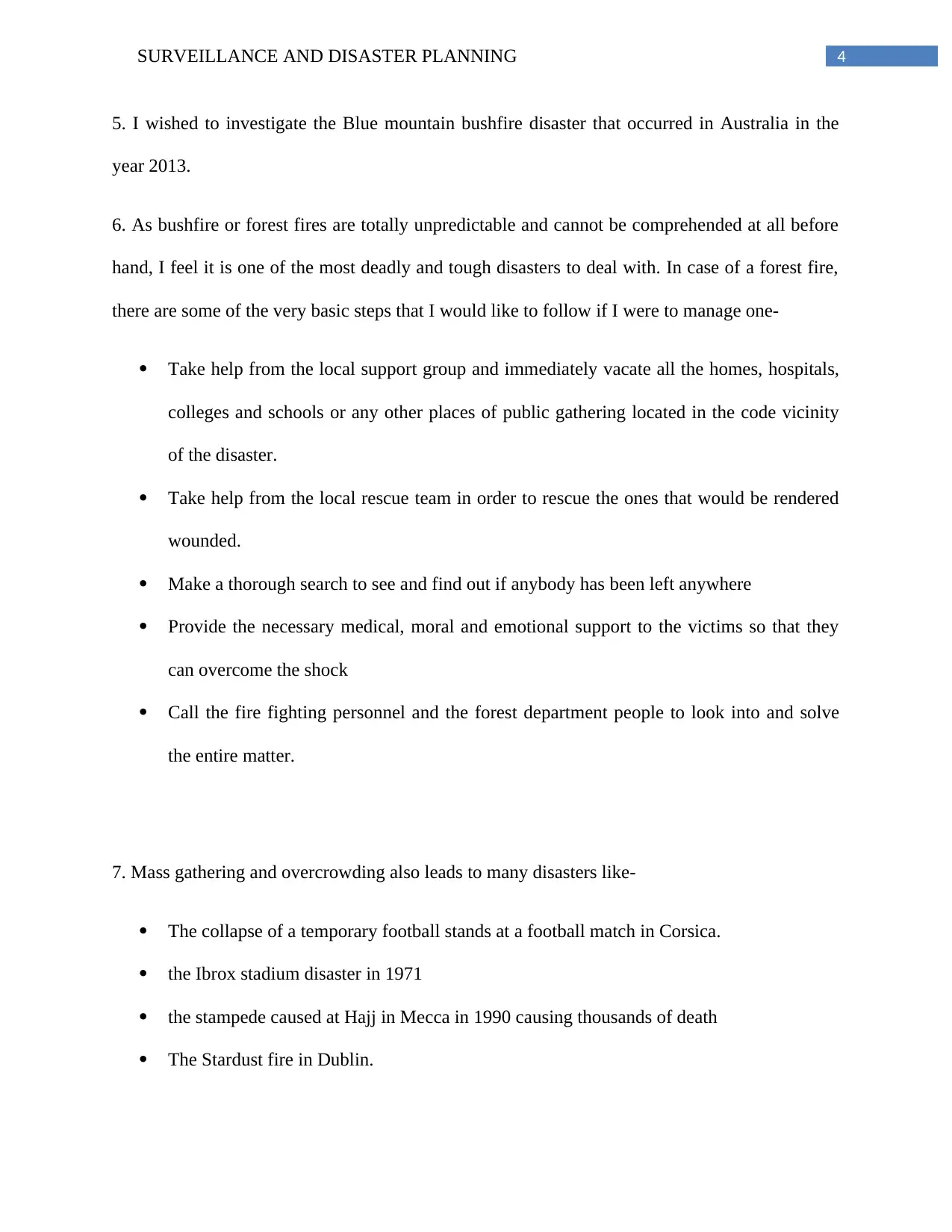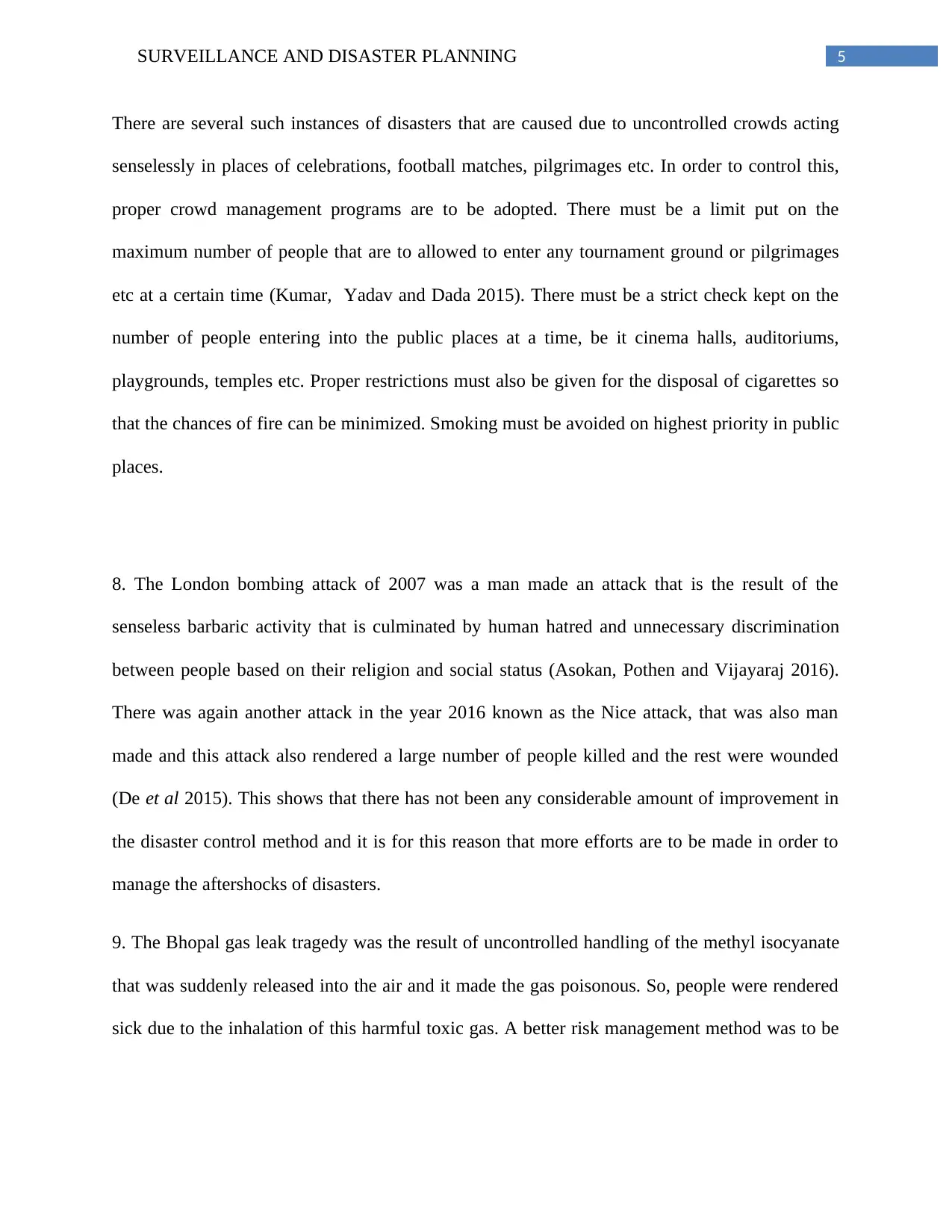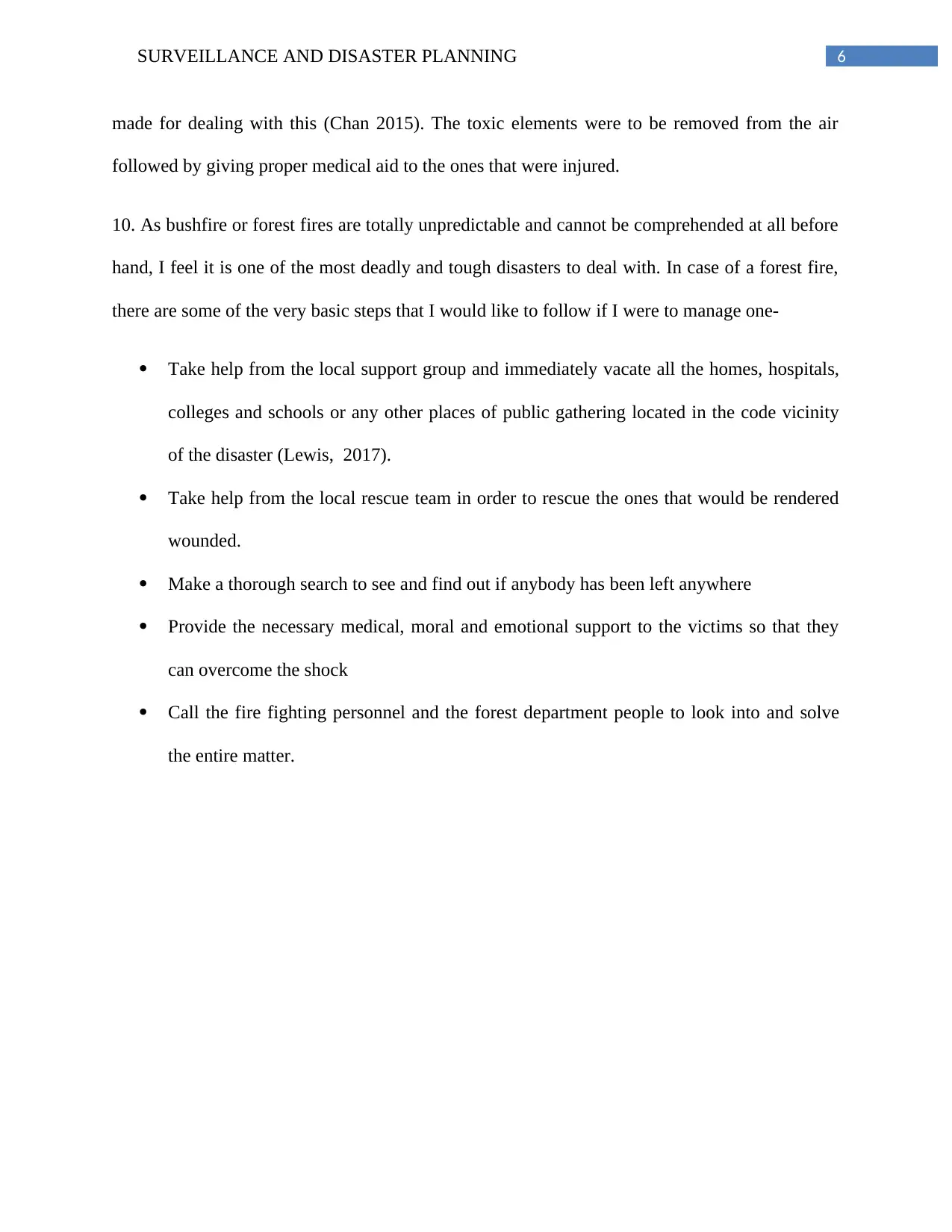Disaster Planning and Surveillance Report: Case Studies and Analysis
VerifiedAdded on 2020/03/02
|7
|1519
|48
Report
AI Summary
This report examines various aspects of disaster planning, starting with an analysis of major disasters like the Queensland floods, bushfires in the Blue Mountains, and man-made incidents such as the London bombing and Bhopal gas leak. The report categorizes disasters into hydrological, geophysical, and man-made types. It emphasizes the importance of preparedness, support groups, and effective management strategies for both natural and man-made events. The author provides insights into personal responses to disasters, crowd management, and the need for improved disaster control methods. The report also includes a list of references for further study, making it a comprehensive resource for understanding disaster planning and response.

Running head: DISASTER PLANNING
SURVEILLANCE AND DISASTER PLANNING
Name of the student:
Name of the University:
Author’s note:
SURVEILLANCE AND DISASTER PLANNING
Name of the student:
Name of the University:
Author’s note:
Paraphrase This Document
Need a fresh take? Get an instant paraphrase of this document with our AI Paraphraser

2SURVEILLANCE AND DISASTER PLANNING
1. One of the deadliest disasters that I have heard in my lifetime is the Queensland, Victoria
and NSW floods. About three-quarters of Queensland was flooded and was declared to be
a flood zone on 10th January, as the water gushed in large amounts destroying and
devastating towns and destroying about 20000 settlements. It is perhaps the most deadly
floods that have been recorded in the history of Australian disasters. About 35 people
died in the flood rendering thousands of people homeless and penniless. I was extremely
shocked to see this horror that had descended down over the land suddenly and was
contemplating on the rescue events that would follow.
2.
Disaster Classification
Floods in Queensland(2010-2011) Hydrological
Heat wave (2000) Geophysical
Fire(2000) Man made
Air accident Man made
Cyclone and flood Hydrological and metrological
Canberra fires(2003) natural
Mining accident(2013) Man made
Mining and coal refineries accident(2014) Man made
Brisbane floods(2011) hydrological
Cyclone Monica(2006) meterological
1. One of the deadliest disasters that I have heard in my lifetime is the Queensland, Victoria
and NSW floods. About three-quarters of Queensland was flooded and was declared to be
a flood zone on 10th January, as the water gushed in large amounts destroying and
devastating towns and destroying about 20000 settlements. It is perhaps the most deadly
floods that have been recorded in the history of Australian disasters. About 35 people
died in the flood rendering thousands of people homeless and penniless. I was extremely
shocked to see this horror that had descended down over the land suddenly and was
contemplating on the rescue events that would follow.
2.
Disaster Classification
Floods in Queensland(2010-2011) Hydrological
Heat wave (2000) Geophysical
Fire(2000) Man made
Air accident Man made
Cyclone and flood Hydrological and metrological
Canberra fires(2003) natural
Mining accident(2013) Man made
Mining and coal refineries accident(2014) Man made
Brisbane floods(2011) hydrological
Cyclone Monica(2006) meterological

3SURVEILLANCE AND DISASTER PLANNING
3. Blue mountain bush fire
A forest fire is something that happens all of a sudden and also becomes very tough to be
managed instantly. Such a deadly forest fire occurred in Australia in the blue mountain region. It
was perhaps because of the fact that the trees fell onto power lines and due to that commotion,
there was the sudden outbreak of this bush fire. One was in Mt. Victoria whereas the other was in
Springwood. The bushfire was rapid and quite powerful and took control almost in minutes. The
was about 100 kilometers per hour which helped the fire to gain control within minutes.
The most vulnerable were the local residents but as both, the fires happened during the day time
and the rescue work was started rapidly, no serious damage was caused and all the residents were
removed from school, hospitals, homes, and other places.
4. Give yourself time to adjust-People must understand that there will b e several difficult
moments in life and natural disasters and they're after effects are also one of them. One must try
to be patient and thus cope up with the changes.
Finding a local support group in this connection is also very helpful since these support groups
are available for helping out the survivors (Rich et al 2016). People with limited personal support
can also be helped a great deal if group meetings are conducted y this local support and rescue
groups.
3. Blue mountain bush fire
A forest fire is something that happens all of a sudden and also becomes very tough to be
managed instantly. Such a deadly forest fire occurred in Australia in the blue mountain region. It
was perhaps because of the fact that the trees fell onto power lines and due to that commotion,
there was the sudden outbreak of this bush fire. One was in Mt. Victoria whereas the other was in
Springwood. The bushfire was rapid and quite powerful and took control almost in minutes. The
was about 100 kilometers per hour which helped the fire to gain control within minutes.
The most vulnerable were the local residents but as both, the fires happened during the day time
and the rescue work was started rapidly, no serious damage was caused and all the residents were
removed from school, hospitals, homes, and other places.
4. Give yourself time to adjust-People must understand that there will b e several difficult
moments in life and natural disasters and they're after effects are also one of them. One must try
to be patient and thus cope up with the changes.
Finding a local support group in this connection is also very helpful since these support groups
are available for helping out the survivors (Rich et al 2016). People with limited personal support
can also be helped a great deal if group meetings are conducted y this local support and rescue
groups.
⊘ This is a preview!⊘
Do you want full access?
Subscribe today to unlock all pages.

Trusted by 1+ million students worldwide

4SURVEILLANCE AND DISASTER PLANNING
5. I wished to investigate the Blue mountain bushfire disaster that occurred in Australia in the
year 2013.
6. As bushfire or forest fires are totally unpredictable and cannot be comprehended at all before
hand, I feel it is one of the most deadly and tough disasters to deal with. In case of a forest fire,
there are some of the very basic steps that I would like to follow if I were to manage one-
Take help from the local support group and immediately vacate all the homes, hospitals,
colleges and schools or any other places of public gathering located in the code vicinity
of the disaster.
Take help from the local rescue team in order to rescue the ones that would be rendered
wounded.
Make a thorough search to see and find out if anybody has been left anywhere
Provide the necessary medical, moral and emotional support to the victims so that they
can overcome the shock
Call the fire fighting personnel and the forest department people to look into and solve
the entire matter.
7. Mass gathering and overcrowding also leads to many disasters like-
The collapse of a temporary football stands at a football match in Corsica.
the Ibrox stadium disaster in 1971
the stampede caused at Hajj in Mecca in 1990 causing thousands of death
The Stardust fire in Dublin.
5. I wished to investigate the Blue mountain bushfire disaster that occurred in Australia in the
year 2013.
6. As bushfire or forest fires are totally unpredictable and cannot be comprehended at all before
hand, I feel it is one of the most deadly and tough disasters to deal with. In case of a forest fire,
there are some of the very basic steps that I would like to follow if I were to manage one-
Take help from the local support group and immediately vacate all the homes, hospitals,
colleges and schools or any other places of public gathering located in the code vicinity
of the disaster.
Take help from the local rescue team in order to rescue the ones that would be rendered
wounded.
Make a thorough search to see and find out if anybody has been left anywhere
Provide the necessary medical, moral and emotional support to the victims so that they
can overcome the shock
Call the fire fighting personnel and the forest department people to look into and solve
the entire matter.
7. Mass gathering and overcrowding also leads to many disasters like-
The collapse of a temporary football stands at a football match in Corsica.
the Ibrox stadium disaster in 1971
the stampede caused at Hajj in Mecca in 1990 causing thousands of death
The Stardust fire in Dublin.
Paraphrase This Document
Need a fresh take? Get an instant paraphrase of this document with our AI Paraphraser

5SURVEILLANCE AND DISASTER PLANNING
There are several such instances of disasters that are caused due to uncontrolled crowds acting
senselessly in places of celebrations, football matches, pilgrimages etc. In order to control this,
proper crowd management programs are to be adopted. There must be a limit put on the
maximum number of people that are to allowed to enter any tournament ground or pilgrimages
etc at a certain time (Kumar, Yadav and Dada 2015). There must be a strict check kept on the
number of people entering into the public places at a time, be it cinema halls, auditoriums,
playgrounds, temples etc. Proper restrictions must also be given for the disposal of cigarettes so
that the chances of fire can be minimized. Smoking must be avoided on highest priority in public
places.
8. The London bombing attack of 2007 was a man made an attack that is the result of the
senseless barbaric activity that is culminated by human hatred and unnecessary discrimination
between people based on their religion and social status (Asokan, Pothen and Vijayaraj 2016).
There was again another attack in the year 2016 known as the Nice attack, that was also man
made and this attack also rendered a large number of people killed and the rest were wounded
(De et al 2015). This shows that there has not been any considerable amount of improvement in
the disaster control method and it is for this reason that more efforts are to be made in order to
manage the aftershocks of disasters.
9. The Bhopal gas leak tragedy was the result of uncontrolled handling of the methyl isocyanate
that was suddenly released into the air and it made the gas poisonous. So, people were rendered
sick due to the inhalation of this harmful toxic gas. A better risk management method was to be
There are several such instances of disasters that are caused due to uncontrolled crowds acting
senselessly in places of celebrations, football matches, pilgrimages etc. In order to control this,
proper crowd management programs are to be adopted. There must be a limit put on the
maximum number of people that are to allowed to enter any tournament ground or pilgrimages
etc at a certain time (Kumar, Yadav and Dada 2015). There must be a strict check kept on the
number of people entering into the public places at a time, be it cinema halls, auditoriums,
playgrounds, temples etc. Proper restrictions must also be given for the disposal of cigarettes so
that the chances of fire can be minimized. Smoking must be avoided on highest priority in public
places.
8. The London bombing attack of 2007 was a man made an attack that is the result of the
senseless barbaric activity that is culminated by human hatred and unnecessary discrimination
between people based on their religion and social status (Asokan, Pothen and Vijayaraj 2016).
There was again another attack in the year 2016 known as the Nice attack, that was also man
made and this attack also rendered a large number of people killed and the rest were wounded
(De et al 2015). This shows that there has not been any considerable amount of improvement in
the disaster control method and it is for this reason that more efforts are to be made in order to
manage the aftershocks of disasters.
9. The Bhopal gas leak tragedy was the result of uncontrolled handling of the methyl isocyanate
that was suddenly released into the air and it made the gas poisonous. So, people were rendered
sick due to the inhalation of this harmful toxic gas. A better risk management method was to be

6SURVEILLANCE AND DISASTER PLANNING
made for dealing with this (Chan 2015). The toxic elements were to be removed from the air
followed by giving proper medical aid to the ones that were injured.
10. As bushfire or forest fires are totally unpredictable and cannot be comprehended at all before
hand, I feel it is one of the most deadly and tough disasters to deal with. In case of a forest fire,
there are some of the very basic steps that I would like to follow if I were to manage one-
Take help from the local support group and immediately vacate all the homes, hospitals,
colleges and schools or any other places of public gathering located in the code vicinity
of the disaster (Lewis, 2017).
Take help from the local rescue team in order to rescue the ones that would be rendered
wounded.
Make a thorough search to see and find out if anybody has been left anywhere
Provide the necessary medical, moral and emotional support to the victims so that they
can overcome the shock
Call the fire fighting personnel and the forest department people to look into and solve
the entire matter.
made for dealing with this (Chan 2015). The toxic elements were to be removed from the air
followed by giving proper medical aid to the ones that were injured.
10. As bushfire or forest fires are totally unpredictable and cannot be comprehended at all before
hand, I feel it is one of the most deadly and tough disasters to deal with. In case of a forest fire,
there are some of the very basic steps that I would like to follow if I were to manage one-
Take help from the local support group and immediately vacate all the homes, hospitals,
colleges and schools or any other places of public gathering located in the code vicinity
of the disaster (Lewis, 2017).
Take help from the local rescue team in order to rescue the ones that would be rendered
wounded.
Make a thorough search to see and find out if anybody has been left anywhere
Provide the necessary medical, moral and emotional support to the victims so that they
can overcome the shock
Call the fire fighting personnel and the forest department people to look into and solve
the entire matter.
⊘ This is a preview!⊘
Do you want full access?
Subscribe today to unlock all pages.

Trusted by 1+ million students worldwide

7SURVEILLANCE AND DISASTER PLANNING
Reference list
Asokan, A., Pothen, A.J. and Vijayaraj, R.K., 2016, December. ARMatron—A wearable gesture
recognition glove: For control of robotic devices in disaster management and human
Rehabilitation. In Robotics and Automation for Humanitarian Applications (RAHA), 2016
International Conference on (pp. 1-5). IEEE.
Chan, N.W., 2015. Impacts of disasters and disaster risk management in malaysia: The case of
floods. In Resilience and Recovery in Asian Disasters(pp. 239-265). Springer Japan.
De Albuquerque, J.P., Herfort, B., Brenning, A. and Zipf, A., 2015. A geographic approach for
combining social media and authoritative data towards identifying useful information for disaster
management. International Journal of Geographical Information Science, 29(4), pp.667-689.
Kumar, S.B., Yadav, R.K. and Dada, R., 2015. Yoga as an effective lifestyle intervention for
Bhopal methyl isocyanate gas leakage catastrophe victims. International journal of yoga, 8(2),
p.162.
Lewis, S., 2017. Extreme climate change: Damage and responsibility. AQ-Australian
Quarterly, 88(1), p.3.
Rich, J., Booth, A., Rowlands, A. and Redd, P., 2016. Bushfire support services and the need for
evaluation: The 2013 Blue Mountains experience. Australian Journal of Emergency
Management, The, 31(1), p.8.
Reference list
Asokan, A., Pothen, A.J. and Vijayaraj, R.K., 2016, December. ARMatron—A wearable gesture
recognition glove: For control of robotic devices in disaster management and human
Rehabilitation. In Robotics and Automation for Humanitarian Applications (RAHA), 2016
International Conference on (pp. 1-5). IEEE.
Chan, N.W., 2015. Impacts of disasters and disaster risk management in malaysia: The case of
floods. In Resilience and Recovery in Asian Disasters(pp. 239-265). Springer Japan.
De Albuquerque, J.P., Herfort, B., Brenning, A. and Zipf, A., 2015. A geographic approach for
combining social media and authoritative data towards identifying useful information for disaster
management. International Journal of Geographical Information Science, 29(4), pp.667-689.
Kumar, S.B., Yadav, R.K. and Dada, R., 2015. Yoga as an effective lifestyle intervention for
Bhopal methyl isocyanate gas leakage catastrophe victims. International journal of yoga, 8(2),
p.162.
Lewis, S., 2017. Extreme climate change: Damage and responsibility. AQ-Australian
Quarterly, 88(1), p.3.
Rich, J., Booth, A., Rowlands, A. and Redd, P., 2016. Bushfire support services and the need for
evaluation: The 2013 Blue Mountains experience. Australian Journal of Emergency
Management, The, 31(1), p.8.
1 out of 7
Your All-in-One AI-Powered Toolkit for Academic Success.
+13062052269
info@desklib.com
Available 24*7 on WhatsApp / Email
![[object Object]](/_next/static/media/star-bottom.7253800d.svg)
Unlock your academic potential
Copyright © 2020–2025 A2Z Services. All Rights Reserved. Developed and managed by ZUCOL.